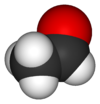We’ll
just discuss in this blog two of the simpler types: aldehydes and ketones.
Let’s begin by looking at the structural formulae of aldehydes.
These
are three aldehydes.
Note
the nomenclature: eth—an—al
The
suffix –al denotes the aldehyde homologous series, the prefix eth– denotes the
number of carbon atoms in the molecule and includes the carbon of the carbonyl
group and the –an– denotes the compound is saturated.
Can
you draw the structural formula of methanal the simplest aldehyde?
Space
filling structures of some of these aldehydes look like this:
Ethanal
CH3CHO
Ketones
on the other hand have alkyl groups on both sides of the carbonyl group
These
are three of the simplest ketone structures.
Here
is a typical space–filling picture of the simple ketone: propanone
Solubility in water:
The
simpler aldehydes and ketones are completely miscible with water.
The
solubility in water decreases as the carbon chain length increases.
Van
der Waals forces (temporary dipole forces) between carbon chains begin to
dominate over the hydrogen bonds formed between the aldehyde and water.
The
hydrogen bond is shown as a dotted line.
Note
that the hydrogen bond is linear with a bond angle of 180o
Distinguishing an
aldehyde from a ketone
There
are a couple of chemical tests you can carry out to see if an aqueous solution
contains a simple aldehyde or a simple ketone.
Both
aldehydes and ketones will form a yellow crystalline precipitate with Bayer’s
Reagent.
But
only aldehydes will form a red precipitate on heating gently with either blue
Fehling’s solution or alkaline Benedict’s solution.
Aldehydes
can be oxidised to carboxylic acids in this redox reaction.
CH3CHO + H2O → CH3COOH + 2H+ +
2e–
The
blue copper(II) solution is reduced to a red precipitate of copper(I) oxide
2Cu
2+ + 2e–
→ 2Cu+
Typical reaction of
an aldehyde or ketone
Aldehydes
and ketones undergo nucleophilic addition reactions with appropriate
nucleophiles such as HCN.
The
reaction with the weak acid HCN occurs in the presence of the soluble salt KCN.
The
KCN is necessary since it provides sufficient CN– ions cyanide/nitrile ions.
KCN
is fully ionised in aqueous solution whereas HCN is partially ionised since HCN
is a weak acid:
HCN +
H2O ⇋ H3O+ +
CN—
The
mechanism of nucleophilic addition looks like this:
Step
one:
Step
Two:
The
negatively charged oxygen abstracts a proton from the HCN molecule
Step
Three:
The
catalyst :CN– is regenerated
If
the ketone is asymmetrical as in the example below the product of the reaction
with HCN is optically active but both optically active isomers form giving rise
to a racemic mixture:
Problem:
What
happens if an aldehyde, say CH3CH2CHO, is used instead of
the ketone?
Can
you work out the structures of the reaction products and see if they are
optically active or not.
Is
in fact a racemic mixture produced?























No comments:
Post a Comment